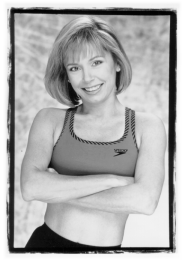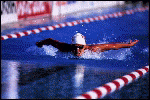Exercise Intensity Measurement For
SwimmingBy Joanne Maybeck - AEA Aquatic Fitness
Instructor. ACSM Exercise Leader ACE Personal Trainer AAAI/ISMA
Prenatal/Postnatal Instructor
 Aquatic exercise (also known as
water aerobics) is increasing in popularity every day! Its true that it is a
wonderful medium for people with injuries, with arthritis or other joint
disorders, for seniors, and for expectant mothers. But more and more, it is
becoming a means of cross-training and an alternative to land-based exercise
for fit participants and even professional athletes. Aquatic exercise (also known as
water aerobics) is increasing in popularity every day! Its true that it is a
wonderful medium for people with injuries, with arthritis or other joint
disorders, for seniors, and for expectant mothers. But more and more, it is
becoming a means of cross-training and an alternative to land-based exercise
for fit participants and even professional athletes.
Something special happens when people enter the
water to exercise. They have fun! And, they do not experience the hot and
sweaty feeling often associated with land exercise. This does not mean that the
workout is not as effective. Rather, the water helps to keep the body cool and
comfortable.
Studies have shown that a training VO2 can be
achieved in deep and shallow water exercise. But, how can instructors and
trainers ensure that participants are exercising at an intensity to achieve
cardiovascular benefits? And, people exercising in the water on their own as
well? Let’s dive into intensity measurement in the pool. And, I’ll
share my own experience.
According to the Aquatic Exercise
Association’s Aquatic Fitness Professional Manual, aquatic heart rates may
be lower than heart rates achieved during comparable land exercise. Several
theories to explain this are:
Temperature:Water cools the body with less effort than air.
This reduced effort means less work for the heart, resulting in a lower heart
rate.
Gravity:Water reduces the effect of gravity on the body.
Blood flows from below the heart back up to it with less effort, resulting in a
lowered heart rate.
Compression: The water is thought to act like a
compressor on all body systems, including the vascular system, causing a
smaller venous load to the heart than equivalent land exercise.
Partial
Pressure: A gas enters a liquid more readily under pressure. In
water exercise, the gas is oxygen and the liquid is the blood. So, more
efficient gas transfer due to water pressure may reduce the workload of the
heart.
Dive
Reflex: This is a primitive reflex associated with a nerve found in
the nasal area. When the face is submerged in water, this reflex lowers heart
rate and blood pressure. This reflex is stronger in some individuals than in
others. Some research suggests that the face doesnt even need to be in the
water for the dive reflex to occur. Some people experience its effect when
standing in chest deep water. And that is the depth at which many aqua aerobics
participants exercise.
Measuring Pulse Count
In aerobic workouts on land, exercisers generally
take a 10 second pulse count at the radial pulse on the wrist or the carotid
artery at the side of the throat. The 10 second count is then multiplied by 6,
to calculate the heart rate in beats per minute (BPM). However, AEA recommends
that water exercisers take a 6 second heart rate count, and multiply by 10. A
10 second pulse count may not be as accurate due to how fast the water can cool
the body.
Even using the 6 second pulse count, a 13% or 17
beats per minute deduction should be taken from the exerciser’s land-based
minimum and maximum training thresholds, according to AEA, due to the effects
of water I have described.
Heart Rate Monitors
I have found that a heart rate monitor is a
superior tool for accurately measuring aqua exercise intensity. My aqua
personal training clients wear a heart rate monitor. I take the 17 BPM
deduction from their land training heart rate target ranges, calculated using
Karvonen’s formula, and advise them of their "aqua target range". I lend
them a monitor to use, and some have later purchased their own monitor,
becoming excited about the ease of accurately gauging their workout
intensity.
To accurately calculate their land training target
rates per Karvonen, my clients sleep while wearing a monitor for 3 consecutive
nights, and record their resting heart rate upon awakening, before rising, on
the 3 mornings. We then take an average of the 3 morning measurements, for the
land-based Karvonen calculation.
| |
Karvonen Formula
To review the Karvonen calculation:
220 - Age= Predicted maximum heart rate- Resting heart rate
(average of 3 mornings)= Heart Rate Reserve
Heart Rate Reserve x .50( )+ Resting heart rate= Minimum
Training Threshold
Heart Rate Reserve x .85 ( )+ Resting Heart Rate= Maximum
Training Threshold
Example: 220- 30 years old= 190
Predicted maximum heart rate- 60 Resting heart rate average of 3 mornings= 130
Heart Rate Reserve
130 x .50= 65+ 60= 125 Minimum Training Threshold
(Land)
130x .85= 111+ 60= 171 Maximum Training Threshold
(Land)
Subtracting 17 BPM, the aqua minimum and maximum training
heart range is 108-154 BPM. |
Some of my aqua class participants also wear heart
rate monitors. We have experienced excellent performance from the monitors
while submerged in the pool. However, I caution clients and class participants
that monitors are not to be used in salt water.
Another practical consideration -- female
exercisers with underwires in their swimsuits have had erroneous or absent
readings. I believe it is due to interference from the metal underwires near
the chest strap of the monitor. Wearing a non-underwire swimsuit with a jog bra
beneath it for additional support, if needed, solves that.
 The foremost reason why I encourage the use
of heart rate monitors is that I find that heart rate measurement using the 6
second method is troublesome for aqua exercisers, and may lead to inaccurate
counts. Because the cooling effect of the water accelerates their heart rate
recovery, by the time they locate their pulse, the 6 second count may no longer
be worthwhile. Also, due to the acoustics in an indoor pool, with music playing
during class or our personal training session, they may be counting the beats
of the music, rather than their pulse. The foremost reason why I encourage the use
of heart rate monitors is that I find that heart rate measurement using the 6
second method is troublesome for aqua exercisers, and may lead to inaccurate
counts. Because the cooling effect of the water accelerates their heart rate
recovery, by the time they locate their pulse, the 6 second count may no longer
be worthwhile. Also, due to the acoustics in an indoor pool, with music playing
during class or our personal training session, they may be counting the beats
of the music, rather than their pulse.
Many report a heart rate that curiously matches
the beats per minute of the music! Another problem with a pulse count is that
aqua exercisers may be wearing webbed gloves to increase drag resistance, or be
using hand buoys or other equipment. By the time they take off or put down this
gear to take their heart rate, heart rate recovery has begun.
So, for people not wearing monitors, I feel that
measuring intensity via perceived exertion is the next best choice. I tell them
that they should feel as if they are working "somewhat hard" to "hard" during
the aerobic component of class or the training session. This corresponds to
ratings of 12 to 16 on Borg’s Rating of Perceived Exertion scale. This is
also AEA’s intensity recommendation.
I also advise them to use the "talk test", in
which they can tell that they are working above their maximum threshold if they
cannot talk while exercising. They should be able to breathe comfortably and
rhythmically. This method is conservative, but very safe.
Water exercise challenges the body, reduces
stress, and most of all, is a wonderful, fun way to help achieve a healthy
lifestyle. I hope these tips help instructors, trainers, and exercisers to make
the most of it!
Visit the Aquatic Exercise
Association (AEA)’s website at
http://www.aeawave.com
for more information
contact Joanne at: FitNYC@aol.com
visit
my website at:http://members.aol.com/fitnyc
|